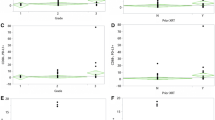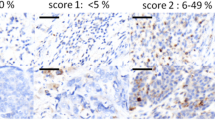Abstract
Spread of head and neck cancer along the cranial nerves is often a lethal complication of this tumour. Current treatment options include surgical resection and/or radiotherapy, but recurrence is a frequent event suggesting that our understanding of this tumour and its microenvironment is incomplete. In this study, we have analysed the nature of the perineural tumour microenvironment by immunohistochemistry with particular focus on immune cells and molecules, which might impair anti-tumour immunity. Moderate to marked lymphocyte infiltrates were present in 58.8 % of the patient cohort including T cells, B cells and FoxP3-expressing T cells. While human leukocyte antigen (HLA) class I and more variably HLA class II were expressed on the tumour cells, this did not associate with patient survival or recurrence. In contrast, galectin-1 staining within lymphocyte areas of the tumour was significantly associated with a poorer patient outcome. Given the known role of galectin-1 in immune suppression, the data suggest that galectin inhibitors might improve the prognosis of patients with perineural spread of cancer.



Similar content being viewed by others
Abbreviations
- ECM:
-
Extracellular matrix
- HLA:
-
Human leukocyte antigen
- HNC:
-
Head and neck cancer
- MRI:
-
Magnetic resonance imaging
- NKT:
-
Natural killer T cells
- SCC:
-
Squamous cell carcinoma
- TIL:
-
Tumour-infiltrating lymphocyte
- Treg:
-
Regulatory T cells
References
Cakir BO, Adamson P, Cingi C (2012) Epidemiology and economic burden of nonmelanoma skin cancer. Facial Plast Surg Clin North Am 20(4):419–422. doi:10.1016/j.fsc.2012.07.004
Panizza B, Warren TA, Solares CA, Boyle GM, Lambie D, Brown I (2013) Histopathological features of clinical perineural invasion of cutaneous squamous cell carcinoma of the head and neck and the potential implications for treatment. Head Neck 36(11):1611–1618. doi:10.1002/hed.23509
Solares CA, Lee K, Parmar P, O’Rourke P, Panizza B (2012) Epidemiology of clinical perineural invasion in cutaneous squamous cell carcinoma of the head and neck. Otolaryngol Head Neck Surg 146(5):746–751. doi:10.1177/0194599811434897
Lin C, Tripcony L, Keller J, Poulsen M, Martin J, Jackson J, Dickie G (2012) Perineural infiltration of cutaneous squamous cell carcinoma and basal cell carcinoma without clinical features. Int J Radiat Oncol Biol Phys 82(1):334–340. doi:10.1016/j.ijrobp.2010.09.040
ten Hove MW, Glaser JS, Schatz NJ (1997) Occult perineural tumor infiltration of the trigeminal nerve. Diagnostic considerations. J Neuroophthalmol 17(3):170–177
Panizza B, Solares CA, Redmond M et al (2011) Surgical resection for clinical perineural invasion from cutaneous squamous cell carcinoma of the head and neck. Head Neck 34:1622–1627
Mbeunkui F, Johann DJ Jr (2009) Cancer and the tumor microenvironment: a review of an essential relationship. Cancer Chemother Pharmacol 63(4):571–582. doi:10.1007/s00280-008-0881-9
Schaaij-Visser TB, de Wit M, Lam SW, Jimenez CR (2013) The cancer secretome, current status and opportunities in the lung, breast and colorectal cancer context. Biochim Biophys Acta 1834(11):2242–2258. doi:10.1016/j.bbapap.2013.01.029
Paltridge JL, Belle L, Khew-Goodall Y (2013) The secretome in cancer progression. Biochim Biophys Acta 1834(11):2233–2241. doi:10.1016/j.bbapap.2013.03.014
Astorgues-Xerri L, Riveiro ME, Tijeras-Raballand A, Serova M, Neuzillet C, Albert S, Raymond E, Faivre S (2014) Unraveling galectin-1 as a novel therapeutic target for cancer. Cancer Treat Rev 40(2):307–319. doi:10.1016/j.ctrv.2013.07.007
Cedeno-Laurent F, Dimitroff CJ (2012) Galectins and their ligands: negative regulators of anti-tumor immunity. Glycoconj J 29(8–9):619–625. doi:10.1007/s10719-012-9379-0
Viguier M, Advedissian T, Delacour D, Poirier F, Deshayes F (2014) Galectins in epithelial functions. Tissue Barriers 2:e29103. doi:10.4161/tisb.29103
Cedeno-Laurent F, Dimitroff CJ (2012) Galectin-1 research in T cell immunity: past, present and future. Clin Immunol 142(2):107–116. doi:10.1016/j.clim.2011.09.011
Yang RY, Rabinovich GA, Liu FT (2008) Galectins: structure, function and therapeutic potential. Expert Rev Mol Med 10:e17. doi:10.1017/S1462399408000719
Hanahan D, Weinberg RA (2011) Hallmarks of cancer: the next generation. Cell 144(5):646–674. doi:10.1016/j.cell.2011.02.013
Schlosser HA, Theurich S, Shimabukuro-Vornhagen A, Holtick U, Stippel DL, Bergwelt-Baildon M (2014) Overcoming tumor-mediated immunosuppression. Immunotherapy 6(9):973–988. doi:10.2217/imt.14.58
Bindea G, Mlecnik B, Fridman WH, Pages F, Galon J (2010) Natural immunity to cancer in humans. Curr Opin Immunol 22(2):215–222. doi:10.1016/j.coi.2010.02.006
Galon J, Fridman WH, Pages F (2007) The adaptive immunologic microenvironment in colorectal cancer: a novel perspective. Cancer Res 67(5):1883–1886. doi:10.1158/0008-5472.CAN-06-4806
Chiang WF, Liu SY, Fang LY, Lin CN, Wu MH, Chen YC, Chen YL, Jin YT (2008) Overexpression of galectin-1 at the tumor invasion front is associated with poor prognosis in early-stage oral squamous cell carcinoma. Oral Oncol 44(4):325–334. doi:10.1016/j.oraloncology.2007.03.004
Ding YM, Dong JH, Chen LL, Zhang HD (2009) Increased expression of galectin-1 is associated with human oral squamous cell carcinoma development. Oncol Rep 21(4):983–987
Alves PM, Godoy GP, Gomes DQ, Medeiros AM, de Souza LB, da Silveira EJ, Vasconcelos MG, Queiroz LM (2011) Significance of galectins-1, -3, -4 and -7 in the progression of squamous cell carcinoma of the tongue. Pathol Res Pract 207(4):236–240. doi:10.1016/j.prp.2011.02.004
Tang CE, Tan T, Li C, Chen ZC, Ruan L, Wang HH, Su T, Zhang PF, Xiao ZQ (2010) Identification of Galectin-1 as a novel biomarker in nasopharyngeal carcinoma by proteomic analysis. Oncol Rep 24(2):495–500
Spano D, Russo R, Di Maso V, Rosso N, Terracciano LM, Roncalli M, Tornillo L, Capasso M, Tiribelli C, Iolascon A (2010) Galectin-1 and its involvement in hepatocellular carcinoma aggressiveness. Mol Med 16(3–4):102–115. doi:10.2119/molmed.2009.00119
Cimmino F, Schulte JH, Zollo M, Koster J, Versteeg R, Iolascon A, Eggert A, Schramm A (2009) Galectin-1 is a major effector of TrkB-mediated neuroblastoma aggressiveness. Oncogene 28(19):2015–2023. doi:10.1038/onc.2009.70
Bacigalupo ML, Manzi M, Rabinovich GA, Troncoso MF (2013) Hierarchical and selective roles of galectins in hepatocarcinogenesis, liver fibrosis and inflammation of hepatocellular carcinoma. World J Gastroenterol 19(47):8831–8849. doi:10.3748/wjg.v19.i47.8831
Tang D, Yuan Z, Xue X, Lu Z, Zhang Y, Wang H, Chen M, An Y, Wei J, Zhu Y, Miao Y, Jiang K (2012) High expression of Galectin-1 in pancreatic stellate cells plays a role in the development and maintenance of an immunosuppressive microenvironment in pancreatic cancer. Int J Cancer 130(10):2337–2348. doi:10.1002/ijc.26290
Rubinstein N, Alvarez M, Zwirner NW, Toscano MA, Ilarregui JM, Bravo A, Mordoh J, Fainboim L, Podhajcer OL, Rabinovich GA (2004) Targeted inhibition of galectin-1 gene expression in tumor cells results in heightened T cell-mediated rejection; A potential mechanism of tumor-immune privilege. Cancer Cell 5(3):241–251
Rabinovich GA, Croci DO (2012) Regulatory circuits mediated by lectin-glycan interactions in autoimmunity and cancer. Immunity 36(3):322–335. doi:10.1016/j.immuni.2012.03.004
Kuo PL, Hung JY, Huang SK, Chou SH, Cheng DE, Jong YJ, Hung CH, Yang CJ, Tsai YM, Hsu YL, Huang MS (2011) Lung cancer-derived galectin-1 mediates dendritic cell anergy through inhibitor of DNA binding 3/IL-10 signaling pathway. J Immunol 186(3):1521–1530. doi:10.4049/jimmunol.1002940
Juszczynski P, Ouyang J, Monti S, Rodig SJ, Takeyama K, Abramson J, Chen W, Kutok JL, Rabinovich GA, Shipp MA (2007) The AP1-dependent secretion of galectin-1 by Reed Sternberg cells fosters immune privilege in classical Hodgkin lymphoma. Proc Natl Acad Sci USA 104(32):13134–13139. doi:10.1073/pnas.0706017104
Banh A, Zhang J, Cao H, Bouley DM, Kwok S, Kong C, Giaccia AJ, Koong AC, Le QT (2011) Tumor galectin-1 mediates tumor growth and metastasis through regulation of T-cell apoptosis. Cancer Res 71(13):4423–4431. doi:10.1158/0008-5472.CAN-10-4157
Le QT, Shi G, Cao H, Nelson DW, Wang Y, Chen EY, Zhao S, Kong C, Richardson D, O’Byrne KJ, Giaccia AJ, Koong AC (2005) Galectin-1: a link between tumor hypoxia and tumor immune privilege. J Clin Oncol 23(35):8932–8941. doi:10.1200/JCO.2005.02.0206
van den Brule FA, Waltregny D, Castronovo V (2001) Increased expression of galectin-1 in carcinoma-associated stroma predicts poor outcome in prostate carcinoma patients. J Pathol 193(1):80–87. doi:10.1002/1096-9896(2000)9999:9999<:AID-PATH730>3.0.CO;2-2
Garin MI, Chu CC, Golshayan D, Cernuda-Morollon E, Wait R, Lechler RI (2007) Galectin-1: a key effector of regulation mediated by CD4 + CD25 + T cells. Blood 109(5):2058–2065. doi:10.1182/blood-2006-04-016451
Toscano MA, Bianco GA, Ilarregui JM, Croci DO, Correale J, Hernandez JD, Zwirner NW, Poirier F, Riley EM, Baum LG, Rabinovich GA (2007) Differential glycosylation of TH1, TH2 and TH-17 effector cells selectively regulates susceptibility to cell death. Nat Immunol 8(8):825–834. doi:10.1038/ni1482
Pages F, Galon J, Dieu-Nosjean MC, Tartour E, Sautes-Fridman C, Fridman WH (2010) Immune infiltration in human tumors: a prognostic factor that should not be ignored. Oncogene 29(8):1093–1102. doi:10.1038/onc.2009.416
Ladoire S, Arnould L, Mignot G, Coudert B, Rebe C, Chalmin F, Vincent J, Bruchard M, Chauffert B, Martin F, Fumoleau P, Ghiringhelli F (2011) Presence of Foxp3 expression in tumor cells predicts better survival in HER2-overexpressing breast cancer patients treated with neoadjuvant chemotherapy. Breast Cancer Res Treat 125(1):65–72. doi:10.1007/s10549-010-0831-1
Taylor RC, Patel A, Panageas KS, Busam KJ, Brady MS (2007) Tumor-infiltrating lymphocytes predict sentinel lymph node positivity in patients with cutaneous melanoma. J Clin Oncol 25(7):869–875. doi:10.1200/JCO.2006.08.9755
Reichert TE, Strauss L, Wagner EM, Gooding W, Whiteside TL (2002) Signaling abnormalities, apoptosis, and reduced proliferation of circulating and tumor-infiltrating lymphocytes in patients with oral carcinoma. Clin Cancer Res 8(10):3137–3145
Kyrgidis A, Tzellos TG, Kechagias N, Patrikidou A, Xirou P, Kitikidou K, Bourlidou E, Vahtsevanos K, Antoniades K (2010) Cutaneous squamous cell carcinoma (SCC) of the head and neck: risk factors of overall and recurrence-free survival. Eur J Cancer 46(9):1563–1572. doi:10.1016/j.ejca.2010.02.046
Csiba A, Whitwell HL, Moore M (1984) Distribution of histocompatibility and leucocyte differentiation antigens in normal human colon and in benign and malignant colonic neoplasms. Br J Cancer 50(5):699–709
Seliger B, Hohne A, Knuth A, Bernhard H, Ehring B, Tampe R, Huber C (1996) Reduced membrane major histocompatibility complex class I density and stability in a subset of human renal cell carcinomas with low TAP and LMP expression. Clin Cancer Res 2(8):1427–1433
Seliger B, Hohne A, Knuth A, Bernhard H, Meyer T, Tampe R, Momburg F, Huber C (1996) Analysis of the major histocompatibility complex class I antigen presentation machinery in normal and malignant renal cells: evidence for deficiencies associated with transformation and progression. Cancer Res 56(8):1756–1760
Acknowledgments
We acknowledge the support of the Princess Alexandra Hospital Private Practice Fund.
Author information
Authors and Affiliations
Corresponding author
Ethics declarations
Conflict of interest
All authors declare that they have no conflict of interest.
Additional information
Graham R. Leggatt and Benedict J. Panizza have contributed equally to this work.
Graham R. Leggatt and Benedict J. Panizza share last authorship.
Rights and permissions
About this article
Cite this article
Chawla, S., Warren, T.A., Wockner, L.F. et al. Galectin-1 is associated with poor prognosis in patients with cutaneous head and neck cancer with perineural spread. Cancer Immunol Immunother 65, 213–222 (2016). https://doi.org/10.1007/s00262-015-1788-z
Received:
Accepted:
Published:
Issue Date:
DOI: https://doi.org/10.1007/s00262-015-1788-z




